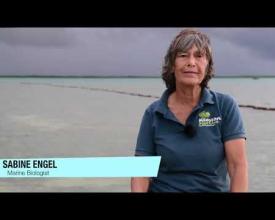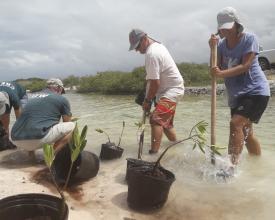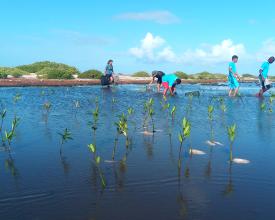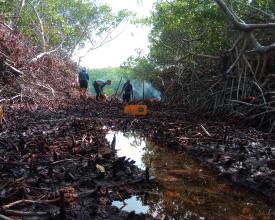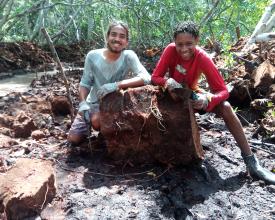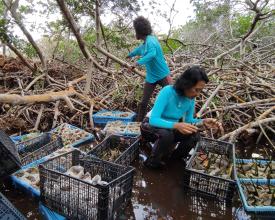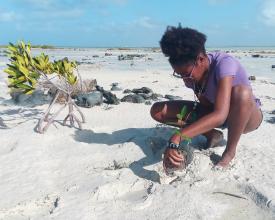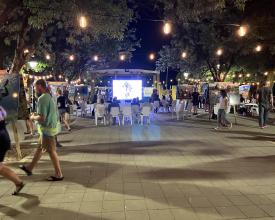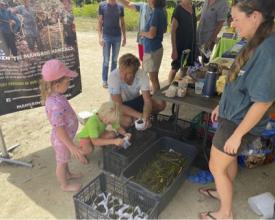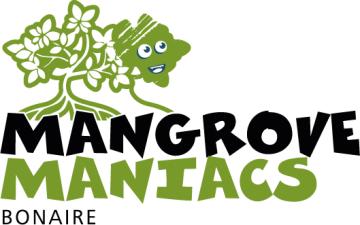
Mangrove Restoration Bonaire
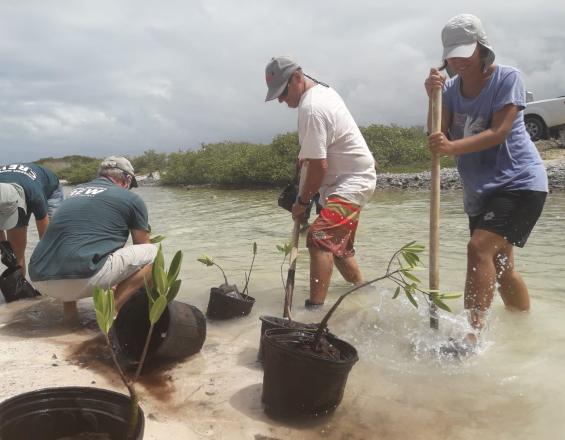
The Bonaire Mangrove Restoration focuses on the mangroves in Lac that are threatened by silting up through excessive erosion. Analysis of satellite imagery shows this impact, and studies in the catchment area indicate locations for potential interventions. Through this project, the affected area has been mapped, ownership has been determined and initial interventions - reforestation - have taken place. Reduced water circulation in the forest further decreases the health of the mangroves. By opening up closed channels the water circulation has been improved, also improving the conditions for the mangroves. Indicators for this are salinity, natural colonization of areas by propagules and an in-depth hydrological study. As a final element, a nursery has been set up in the forest where the natural tidal flow makes watering unnecessary. In the nursery, propagules of mangroves have been raised. Planting of nursery-grown saplings functioned both as reforestation, but also as outreach for the whole community.
Context
Challenges addressed
Effects of climate change are sea level rise and more extreme weather. Mangroves are considered the first line of coastal defence.
However, mangroves are threatened by erosion, reduced water circulation, sargassum influxes and climate change effects. The watershed bordering Lac Bay is overgrazed by donkeys and goats. This leaves the area prone to erosion - sediments reach the backwaters and cause silting up and hypersalinity, and this caused a massive die back - in the period 2014 - 2020 over 8% of the area died back.
Healthy mangroves need good water circulation; the water circulation is facilitated by the tidal flow but hampered by increased sedimentation, a reduced tidal prism and the blocking of the waterways by the growth of mangrove roots.
Since 2018 Lac Bay has experienced increased sargassum influxes. Sargassum enters the bay and upon reaching the coast dies and decomposes, thus resulting in an additional 1% loss of mangroves in the period 2018 - 2020.
Location
Process
Summary of the process
Even though the different interventions (building blocks) can be executed independently, they form a coherent approach to make the success of the project complete. There is also overlap and a lot of interrelation between them. A forest stays healthy when the water circulation is optimal and propagules will be available for the nurseries. The seedlings from the nurseries are needed to improve the degraded areas, for reforestation. A lot of activities to increase community awareness involve people participating in one of the activities where they will have onhand experience and will better understand the mangrove habitat, and for whom the importance of mangroves can be explained.
Building Blocks
Restore water circulation in the mangrove forest.
The water in the mangrove forest needs to refresh and be of good quality (salinity, dissolved oxygen, pH) in order for the mangroves and the organisms that are part of the mangrove habitat to flourish, like fish, sponges, anemones and mangrove oysters. The force behind the water circulation is the tidal flow; there is no river feeding the mangroves. The water moves through the roots as sheet flow, the channels and the lagoons. The growth of roots and accumulation of sediments reduce the capacity of the system to bring water in a timely fashion to all parts of the mangrove forest - especially the part farthest removed from the open ocean is most under stress.
Enabling factors
-
Knowledge from fishermen helped locate the historical channels.
-
Hydrological studies executed before and during the execution of the project helped decision-making on priority channels, setting their dimensions.
-
A good group of volunteers was able to assist in the work that was executed manually.
Lesson learned
- Use of mechanical equipment was not possible.
Resources
Establish nurseries
We established 5 nurseries in the network of opened channels and raised 5600 propagules, mostly red mangroves but also black mangroves. Recently we have studied the white mangroves to assess their importance and have done a pilot on white mangrove propagation. Most of these propagules grew out into healthy saplings and have been outplanted in 5 events. Afterwards, the outplants have been monitored by interns. A successful nursery will increase mangrove plants available for reforestation efforts, emphasizing the need for an ecosystem-based approach to building resilience on the island.
Enabling factors
-
Volunteers took charge of this part of the restoration work.
-
Propagules availability.
-
Availability and easy access to viable locations for nurseries.
Lesson learned
-
Raising black mangroves would not survive prolonged inundation and effective adjustments could be taken.
-
Different seasons allowed for different availability of propagules per species - but propagules of red mangroves were available throughout the year. In the season of the black mangroves, we focused on this species to have a good stock of black mangrove saplings. White mangroves preferred a land bases nursery.
-
Pots and plastic planting bags were used initially. They were expensive and needed additional handling of the saplings. In a later stage, we started to use biodegradable bags that could be left in place when the saplings were planted.
Resources
Reforestation in degraded and sparsely vegetated areas
Enhancing the conditions in the degraded areas, eleminating threats in the mangrove forest will lead to natural regeneration. However the restauration can be sped up by using nursery grown saplings. New plants from the nursery are used in degraded areas and along the coast to support reforestation efforts. Expanded mangrove forests will form a first line of coastal defense for extreme weather conditions and rising sea levels, supporting an ecosystem-based approach to climate change adaptation and mitigation on the island. This also includes a pilot program to encourage regrowth of mangroves in degraded areas and demonstrate intervention method success.
Enabling factors
-
There was a ready supply of saplings from the nurseries.
-
Planting mangrove saplings could be done by anybody and was a good activity to raise awareness. Outpanting events always raised enough volunteers in the community
-
The availability of propagules and good functioning nurseries provided enough plants for the outplanting efforts.
Lesson learned
Initially, plastic pots and bags were used (see block 2). The use of biodegradable bags decreased transportation space and handling of the saplings, thus increasing survivability.
Resources
Increase community awareness and involvement
This project encouraged the participation of youth and community volunteers to gain support and increase local knowledge of the importance of protecting local ecosystems. Increased community involvement will work to build capacity while empowering and strengthening local conservation efforts. The group of volunteers we currently work with is a mix of residents and visitors, men and women, young and old and from a wide range of backgrounds.
Efforts are made to keep policymakers involved and inform them of the importance of mangroves in general and restoration in particular to gain their support.
Enabling factors
-
Supportive community, whenever activities are anounced they respond readily
-
the actvities organised for engaging the community are diverse (tours in the mangrove forest, events, presentation evenings) and thus cater to a variety of groups like school groups, junior rangers, general public, science community and stakeholders operating in the area.
-
Easy access to media outlets.
-
Momentum reached (having reached a lot of local, regional and international exposure).
Lesson learned
-
Collaborating with other nature organisations helped reach more people.
-
Advertisements for events could be improved by divulging information through other media channels, e.g. radio.
-
Organising different forms of outreach activities, such as public presentations, encouraged community engagement.
-
Even though most residents speak English, communicating in both the local language and English gives a better result.
Resources
Impacts
In the course of the project, we managed to:
- Opening of 400 m new channels.
- Maintenance of the whole network of over 3500 m, which improves a surface area of over 1600 sqm - ultimately connecting an area of 105.600 sqm.
- Establishment of 5 nurseries in the network of opened channels and raised 5600 propagules, mostly red mangroves but also black mangroves.
- Study of the white mangroves to assess their importance.
- Delivery of a pilot on white mangrove propagation. Most of these propagules grew out into healthy saplings and have been outplanted in 5 events. Afterwards, the outplants have been monitored by interns. These outplanting events have been done with the residents of Bonaire, all ages or groups like the high school and junior Rangers.
- Active community engagement, including volunteers, through outreach and awareness on social media, articles in local and regional papers and numerous events (Kids Days, public presentations, World Wetlands Day, Day of the Mangroves, World Biodiversity Day).
Beneficiaries
Residents of Bonaire. Organizations involved in restoration or managing adjacent areas like STINAPA, a non-governmental, not for profit commissioned by the island government to manage the two protected areas of Bonaire.
Sustainable Development Goals
Story
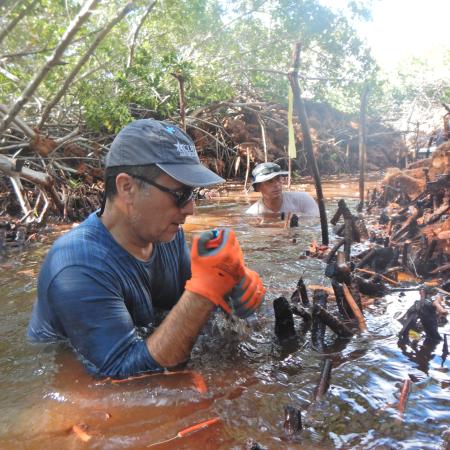
Already a long time ago, the degradation of the mangrove forest of Lac Bay Bonaire was noted and possible causes for this were investigated. Trees were dying and annual fish die-off occurred in the backwaters. The restoration started as a small activity for clearing the closed-off channels with already modest effects.
We started in 2015 with a small group of fishermen, a project coordinator, students and volunteers. Working together and seeing the positive results empowered the group and gave a sense of ownership to the project. The group joining grew, taking more and more responsibility for the job at hand. A bit more effort was dedicated to the mangrove forest over time until it now has grown into a full-fledged restoration effort where the results of the work are visible.
More fish, healthy trees and flowing waters are some results everybody is proud of. The approach is based on infield learning and scientific input. Momentum is gained and more and more support is obtained. The message comes across clearly: the mangroves are very important and we need to take care of them. Nationally and internationally the message is received, and people reach out to support and learn more about the project.
